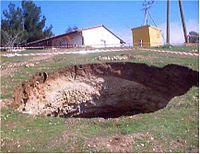Tag:natural=sinkhole
 |
| Description |
|---|
| A natural depression or hole in the surface topography. |
| Group: natural |
| Used on these elements |
| Useful combination |
|
| See also |
| Status: approved |
| Tools for this tag |
A ![]() sinkhole, also known as a sink, shake hole, snake hole, swallow hole, swallet, doline, or cenote, is a natural depression or hole in the surface topography caused by the removal of soil or bedrock, often both, by water and/or by collapse of an underlying cavity. A typical form of a sinkhole is a crater. Sinkholes are abundant on
sinkhole, also known as a sink, shake hole, snake hole, swallow hole, swallet, doline, or cenote, is a natural depression or hole in the surface topography caused by the removal of soil or bedrock, often both, by water and/or by collapse of an underlying cavity. A typical form of a sinkhole is a crater. Sinkholes are abundant on ![]() karst plateaus.
karst plateaus.
Don't mix this up with a ![]() polje, which is much larger, or with a
polje, which is much larger, or with a natural=cave_entrance. On the bottom of a sinkhole, however, there may be a cave entrance. In this case, you may wish to map both, if the sinkhole is of remarkable size; or the cave entrance only, otherwise.
Sinkholes vary in size from 1 to 600 m (3.3 to 2,000 ft) both in diameter and depth, and vary in form from soil-lined bowls to bedrock-edged chasms.
Consider also tagging any cliffs using natural=cliff
This tag can be specified using sinkhole=*, to precise the type of sinkhole; for OSM, used with anthropogenic=yes, natural=sinkhole and sinkhole=* can describe an anthropogenic sinkhole-like orifice, a cave-in for instance. Remember that natural=* doesn't necessarily designate natural features.
Photos
-
Great Blue Hole
 Great Blue Hole - a rare case of a submarine doline (mapped as
Great Blue Hole - a rare case of a submarine doline (mapped as natural=cave_entrance) -
a fresh and short-lived sinkhole. Note that short lived features are not mappable in OSM, so it is not useful to map sinkholes that are going to be filled within days.
See also
natural=cave_entrance– for the entrance to an underground cave, often found associated with sinkholes.natural=cliff– to map vertical or near-vertical rock faces, including the edges of some sinkholes.natural=blowhole– an opening to a sea cave which has grown landwards resulting in blasts of water from the opening due to the wave action.waterway=soakhole– The point at which a river or stream percolates into or through the soil.man_made=mineshaft– man-made vertical mine entranceinlet=bell_mouth– man-made spillway/inlet, typically used in reservoirs, that resembles a ponor sinkhole- Proposal:Natural=cave – detailed mapping of caves
hazard=hole


